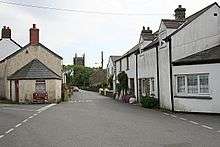St Newlyn East
Coordinates: 50°22′01″N 5°03′18″W / 50.367°N 5.055°W



St Newlyn East (Cornish: Eglosniwlin) is a civil parish and village in Cornwall, England, United Kingdom. The village is situated approximately three miles (5 km) south of Newquay.[1] The name St Newlyn East is locally abbreviated to Newlyn East.
The parish is named after the patron saint of the church, St Newlina and the population was 1,390 in the 2001 census, increasing to 1,635 at the 2011 census[2] There is also an electoral ward named Newlyn and Goonhavern which following the 2011 census had a population of 4,933[3]
The Lappa Valley Steam Railway tourist attraction operates near Newlyn East. At Trerice is the Tudor mansion of the Arundells now in the care of the National Trust. To the northeast is Tresillian House.
Church of St Newlina and the Manor of Cargoll
The church was founded in Norman times and rededicated in 1259. Most of the present building is of the 14th and 15th centuries. There is a fine Norman font.[4]
Cargoll Farm Barn is a listed 15th century barn which belonged to the manor of Cargoll. The manor was recorded in the Domesday Book (1086); it was then held by Robert, Count of Mortain, from Bodmin Monastery. There were two hides of land and land for 15 ploughs. The lord held land for 3 ploughs with 16 serfs, and 16 villeins and 22 smallholders had land for 6 ploughs. There was also a mill which paid 2/6, 4 acres of woodland and 2 square leagues of pasture. The livestock was 12 mares, 7 cattle, 7 pigs, 60 sheep and 12 goats. The value of the manor was £3 sterling though it had formerly been worth £10.[5] This manor and the advowson of the church were purchased by the Bishop of Exeter in 1269 from the Valletorts. The lands of the manor were extensive and it is likely that the bishop's palace within the manor was at Lanner in the parish of St Allen, rather than at Cargoll itself. In 1283 the manor was appropriated by Bishop Peter Quivel to the chancellorship of the cathedral and thereafter several generous gifts were made to the church by the chandellors.[6] At Cargoll a fair and annual market were held from the year 1311 onwards.[7]
East Wheal Rose disaster
On 9 July 1846 a disaster at the East Wheal Rose mine was caused by an unusually heavy thunderstorm which flooded the mine. Thirty-nine of the miners (mainly inhabitants of the village and its immediate vicinity) were drowned.[8] The mine was eventually closed in 1881.
After the disaster, villagers of St Newlyn East worked together and dug a pit in remembrance of the miners who died. The pit is still there today, and has been used frequently for church meetings and tea gatherings etc. When the pit was actually made, it was also used for Cornish wrestling, and was recently re-dug and made more usable with funding from the National Lottery Fund.
The St. Newlyn East Pit was already in existence at the time of the mining disaster and was used by a local preacher to preach sermons, as it provided shelter when the weather was inclement. It was originally an abandoned quarry. After the mining disaster, the pit was graded into tiers and dedicated to the memory of those who died in the disaster. It was restored with the aid of lottery funds in about 2003. More recently, the lease was taken over by the Parish Council and a new Management Committee formed to manage and promote the use of the Pit.
St. Newlyn East Wartime Weekend
St. Newlyn East is known for the annual St. Newlyn East Wartime Weekend which takes place at the village recreational field and village hall.
Notable people
Mary Watson, born at Fiddlers' Green, near St Newlyn East, emigrated to Australia. She was 21 years old and had been married less than eighteen months when she died of thirst on No. 5 Island in the Howick Group off Cape Flattery in Far North Queensland, Australia, in 1881.
References
- ↑ Ordnance Survey: Landranger map sheet 200 Newquay & Bodmin ISBN 978-0-319-22938-5
- ↑ "Parish population 2011.Retrieved 10 Feb 2015".
- ↑ "Ward population for 2011 census.Retrieved 10 Feb 2015".
- ↑ Pevsner, N. (1970) Cornwall; 2nd ed. Penguin Books; p. 199
- ↑ Thorn, C. et al., ed. (1979) Cornwall. Chichester: Phillimore; entry 4,10
- ↑ Cornish Church Guide (1925) Truro: Blackford; p. 171
- ↑ Samantha Letters, "Gazetteer of Markets and Fairs in England and Wales to 1516: Cornwall"
- ↑ "The West Briton Newspaper: transcription of article from 17 July 1846.". Julia Mosman & Rita Kopp. Retrieved 2009-07-24.
External links
| Wikimedia Commons has media related to St Newlyn East. |
- "Online Catalogue for Newlyn East". Cornwall Record Office.
- Newlyn East; Vision of Britain
- Cargoll; Domesday map